Tax Law: Analysis of Deductibility, Tax Accounting & GST Implications
VerifiedAdded on 2023/03/30
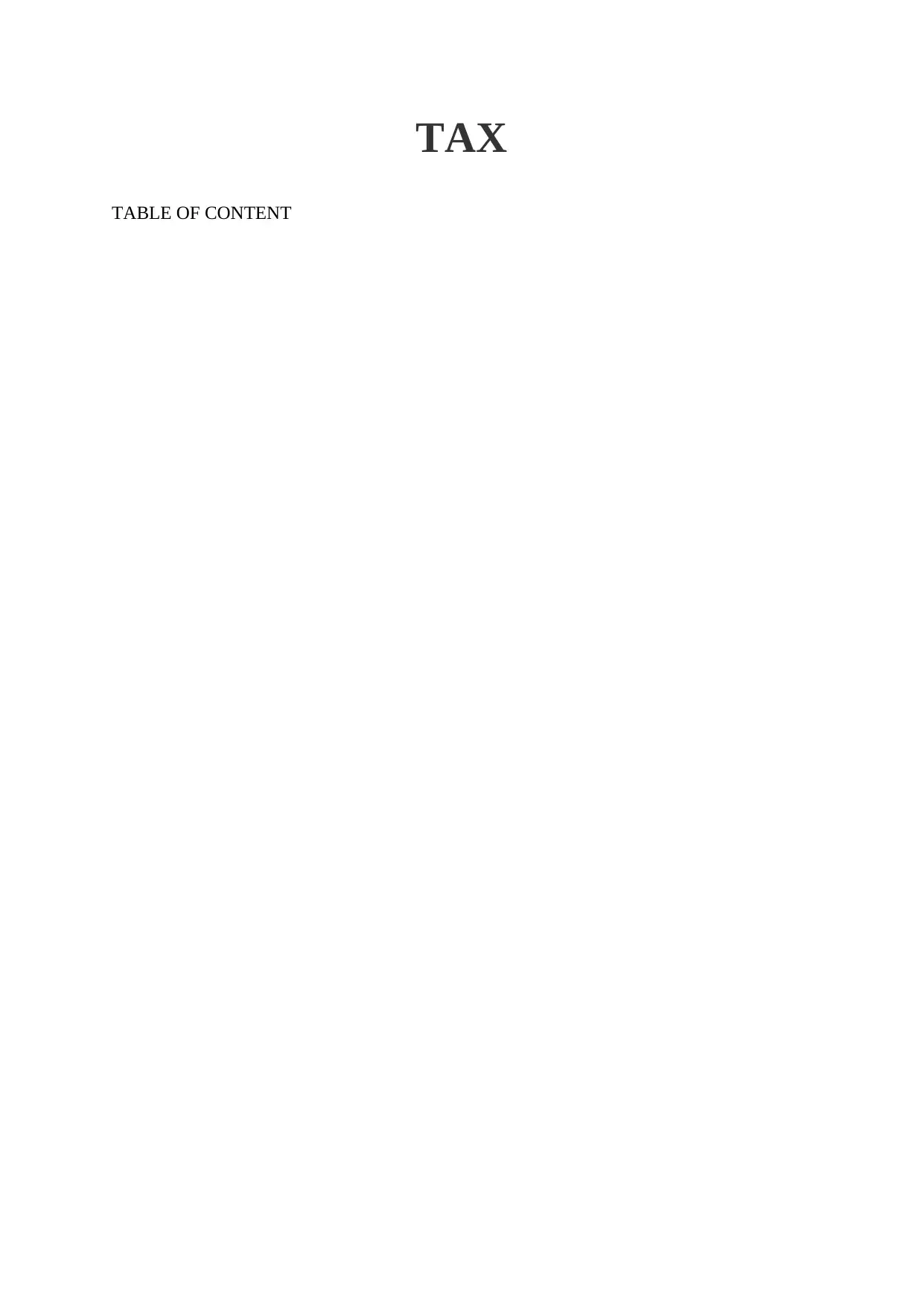
TABLE OF CONTENT
Paraphrase This Document
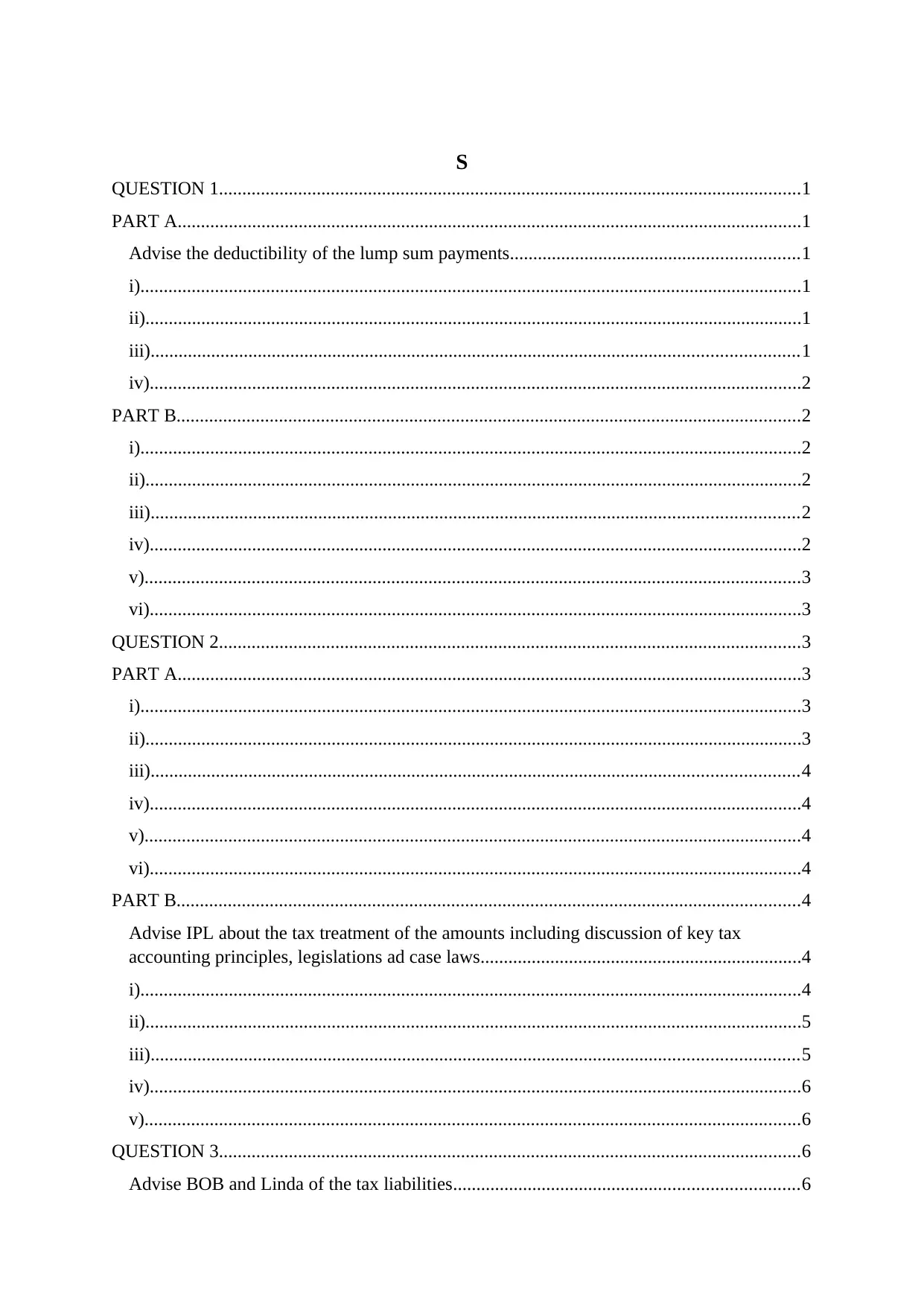
QUESTION 1.............................................................................................................................1
PART A......................................................................................................................................1
Advise the deductibility of the lump sum payments..............................................................1
i)..............................................................................................................................................1
ii).............................................................................................................................................1
iii)...........................................................................................................................................1
iv)............................................................................................................................................2
PART B......................................................................................................................................2
i)..............................................................................................................................................2
ii).............................................................................................................................................2
iii)...........................................................................................................................................2
iv)............................................................................................................................................2
v).............................................................................................................................................3
vi)............................................................................................................................................3
QUESTION 2.............................................................................................................................3
PART A......................................................................................................................................3
i)..............................................................................................................................................3
ii).............................................................................................................................................3
iii)...........................................................................................................................................4
iv)............................................................................................................................................4
v).............................................................................................................................................4
vi)............................................................................................................................................4
PART B......................................................................................................................................4
Advise IPL about the tax treatment of the amounts including discussion of key tax
accounting principles, legislations ad case laws.....................................................................4
i)..............................................................................................................................................4
ii).............................................................................................................................................5
iii)...........................................................................................................................................5
iv)............................................................................................................................................6
v).............................................................................................................................................6
QUESTION 3.............................................................................................................................6
Advise BOB and Linda of the tax liabilities..........................................................................6
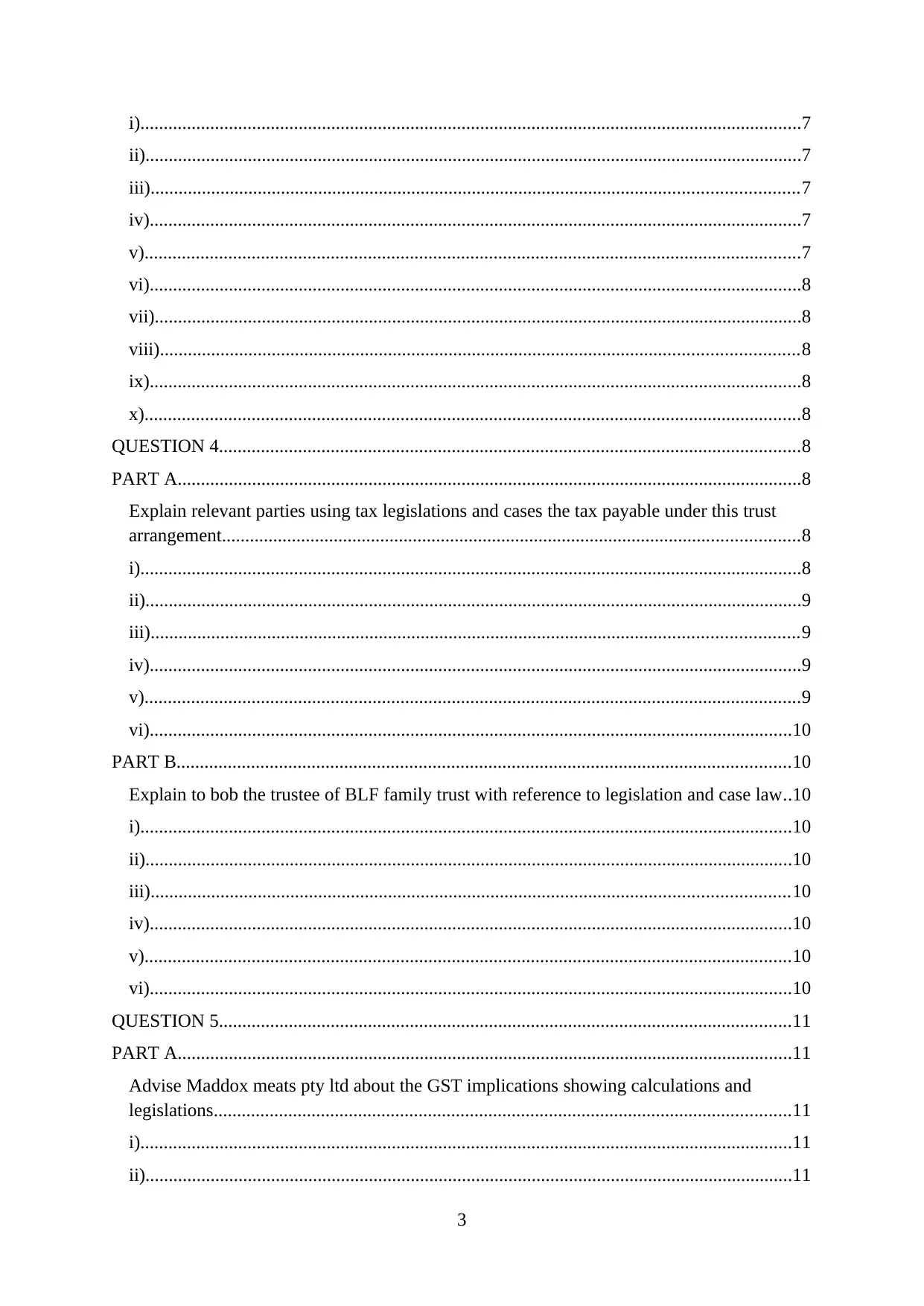
ii).............................................................................................................................................7
iii)...........................................................................................................................................7
iv)............................................................................................................................................7
v).............................................................................................................................................7
vi)............................................................................................................................................8
vii)...........................................................................................................................................8
viii).........................................................................................................................................8
ix)............................................................................................................................................8
x).............................................................................................................................................8
QUESTION 4.............................................................................................................................8
PART A......................................................................................................................................8
Explain relevant parties using tax legislations and cases the tax payable under this trust
arrangement............................................................................................................................8
i)..............................................................................................................................................8
ii).............................................................................................................................................9
iii)...........................................................................................................................................9
iv)............................................................................................................................................9
v).............................................................................................................................................9
vi)..........................................................................................................................................10
PART B....................................................................................................................................10
Explain to bob the trustee of BLF family trust with reference to legislation and case law..10
i)............................................................................................................................................10
ii)...........................................................................................................................................10
iii).........................................................................................................................................10
iv)..........................................................................................................................................10
v)...........................................................................................................................................10
vi)..........................................................................................................................................10
QUESTION 5...........................................................................................................................11
PART A....................................................................................................................................11
Advise Maddox meats pty ltd about the GST implications showing calculations and
legislations............................................................................................................................11
i)............................................................................................................................................11
ii)...........................................................................................................................................11
3
⊘ This is a preview!⊘
Do you want full access?
Subscribe today to unlock all pages.

Trusted by 1+ million students worldwide
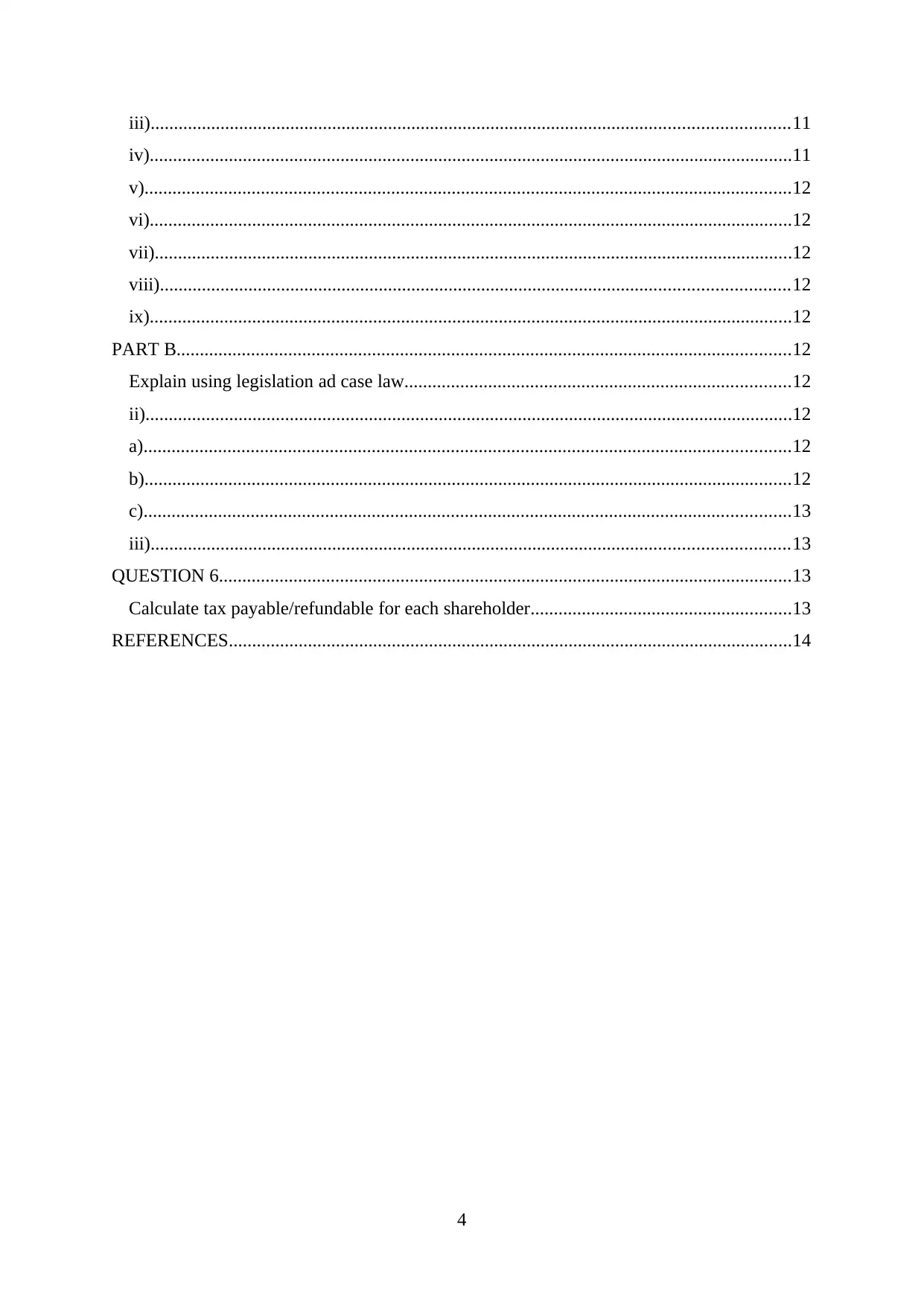
iv)..........................................................................................................................................11
v)...........................................................................................................................................12
vi)..........................................................................................................................................12
vii).........................................................................................................................................12
viii).......................................................................................................................................12
ix)..........................................................................................................................................12
PART B....................................................................................................................................12
Explain using legislation ad case law...................................................................................12
ii)...........................................................................................................................................12
a)...........................................................................................................................................12
b)...........................................................................................................................................12
c)...........................................................................................................................................13
iii).........................................................................................................................................13
QUESTION 6...........................................................................................................................13
Calculate tax payable/refundable for each shareholder........................................................13
REFERENCES.........................................................................................................................14
4
Paraphrase This Document

PART A
Advise the deductibility of the lump sum payments
i)
Issue- To know that non-deductible capital expense relates to the business structure or not
Law- Section 8-1 of ITAA
Application-The person cannot deduct the loss from its income if they satisfy the given
condition that a loss arises of a nature to the capital and a specific loss arises from an activity
that is basically associated with private as well as domestic in nature.
Conclusion-A lumps sum payment of $10000 falls under the first category where this
payment made for producing income by selling the Italian brand olive oil, and this is not a
non-deducible capital expense.
ii)
Issue- The deductibility of the capital expenses and revenue expenses
Law- nature of expenses under ITAA
Application-The deductibility of the capital expenses and revenue expenses determine by
assessing the nature of two of the expenditures. The capital expense is related to the assets
held for a long-time period in an entity.
Conclusion- The revenue expense belongs to the business processes is incurred for
generating the revenues.
iii)
Issue- Deductibility of the lump payment
Law- The deductibility of the lump payment depends on some of the conditions which need
to consider in assessing the deduction of all the lump sum payments are given as below:
The benefit of one party while making the payment
Payment made for the future contract
1
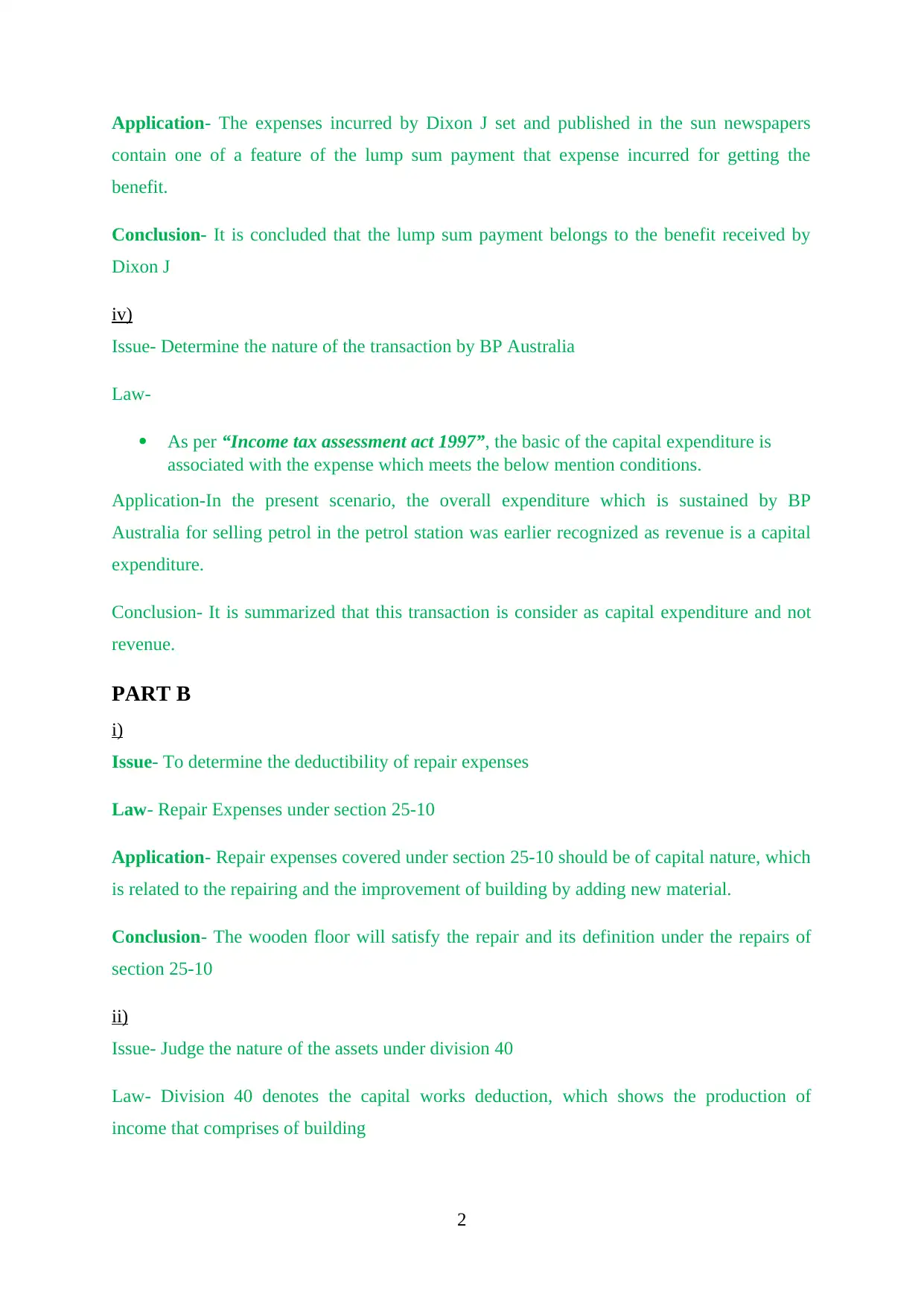
contain one of a feature of the lump sum payment that expense incurred for getting the
benefit.
Conclusion- It is concluded that the lump sum payment belongs to the benefit received by
Dixon J
iv)
Issue- Determine the nature of the transaction by BP Australia
Law-
As per “Income tax assessment act 1997”, the basic of the capital expenditure is
associated with the expense which meets the below mention conditions.
Application-In the present scenario, the overall expenditure which is sustained by BP
Australia for selling petrol in the petrol station was earlier recognized as revenue is a capital
expenditure.
Conclusion- It is summarized that this transaction is consider as capital expenditure and not
revenue.
PART B
i)
Issue- To determine the deductibility of repair expenses
Law- Repair Expenses under section 25-10
Application- Repair expenses covered under section 25-10 should be of capital nature, which
is related to the repairing and the improvement of building by adding new material.
Conclusion- The wooden floor will satisfy the repair and its definition under the repairs of
section 25-10
ii)
Issue- Judge the nature of the assets under division 40
Law- Division 40 denotes the capital works deduction, which shows the production of
income that comprises of building
2
⊘ This is a preview!⊘
Do you want full access?
Subscribe today to unlock all pages.

Trusted by 1+ million students worldwide
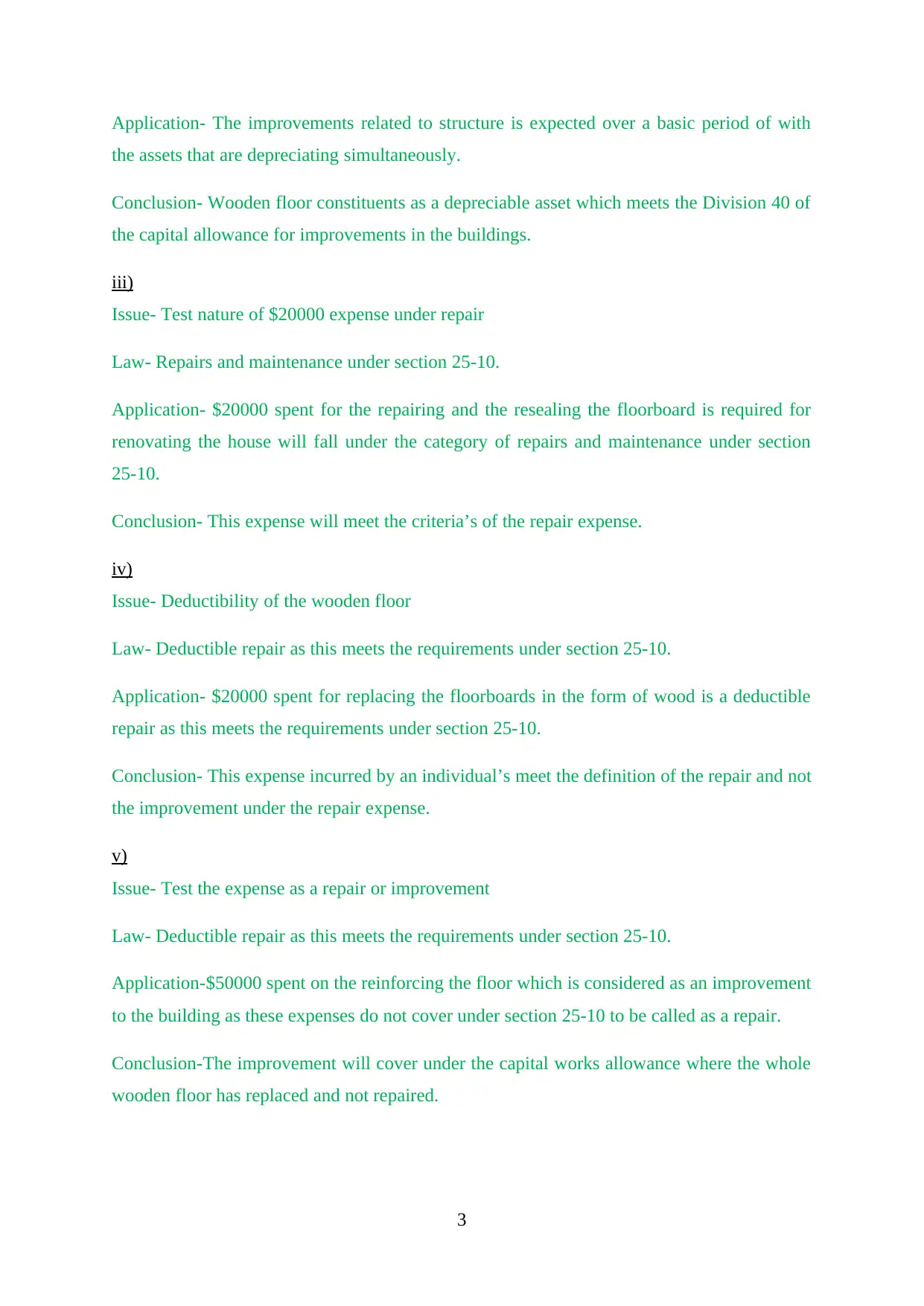
the assets that are depreciating simultaneously.
Conclusion- Wooden floor constituents as a depreciable asset which meets the Division 40 of
the capital allowance for improvements in the buildings.
iii)
Issue- Test nature of $20000 expense under repair
Law- Repairs and maintenance under section 25-10.
Application- $20000 spent for the repairing and the resealing the floorboard is required for
renovating the house will fall under the category of repairs and maintenance under section
25-10.
Conclusion- This expense will meet the criteria’s of the repair expense.
iv)
Issue- Deductibility of the wooden floor
Law- Deductible repair as this meets the requirements under section 25-10.
Application- $20000 spent for replacing the floorboards in the form of wood is a deductible
repair as this meets the requirements under section 25-10.
Conclusion- This expense incurred by an individual’s meet the definition of the repair and not
the improvement under the repair expense.
v)
Issue- Test the expense as a repair or improvement
Law- Deductible repair as this meets the requirements under section 25-10.
Application-$50000 spent on the reinforcing the floor which is considered as an improvement
to the building as these expenses do not cover under section 25-10 to be called as a repair.
Conclusion-The improvement will cover under the capital works allowance where the whole
wooden floor has replaced and not repaired.
3
Paraphrase This Document
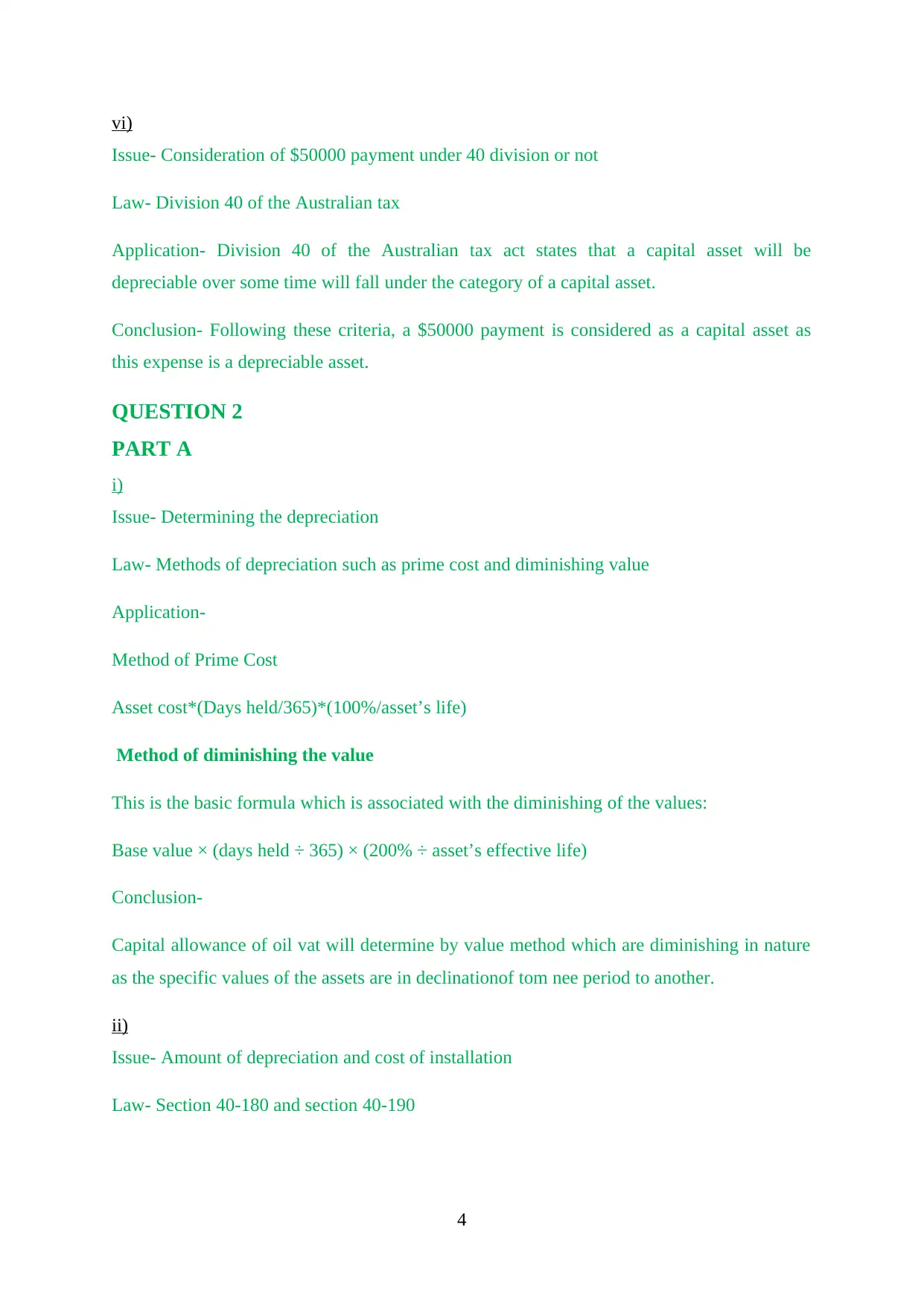
Issue- Consideration of $50000 payment under 40 division or not
Law- Division 40 of the Australian tax
Application- Division 40 of the Australian tax act states that a capital asset will be
depreciable over some time will fall under the category of a capital asset.
Conclusion- Following these criteria, a $50000 payment is considered as a capital asset as
this expense is a depreciable asset.
QUESTION 2
PART A
i)
Issue- Determining the depreciation
Law- Methods of depreciation such as prime cost and diminishing value
Application-
Method of Prime Cost
Asset cost*(Days held/365)*(100%/asset’s life)
Method of diminishing the value
This is the basic formula which is associated with the diminishing of the values:
Base value × (days held ÷ 365) × (200% ÷ asset’s effective life)
Conclusion-
Capital allowance of oil vat will determine by value method which are diminishing in nature
as the specific values of the assets are in declinationof tom nee period to another.
ii)
Issue- Amount of depreciation and cost of installation
Law- Section 40-180 and section 40-190
4
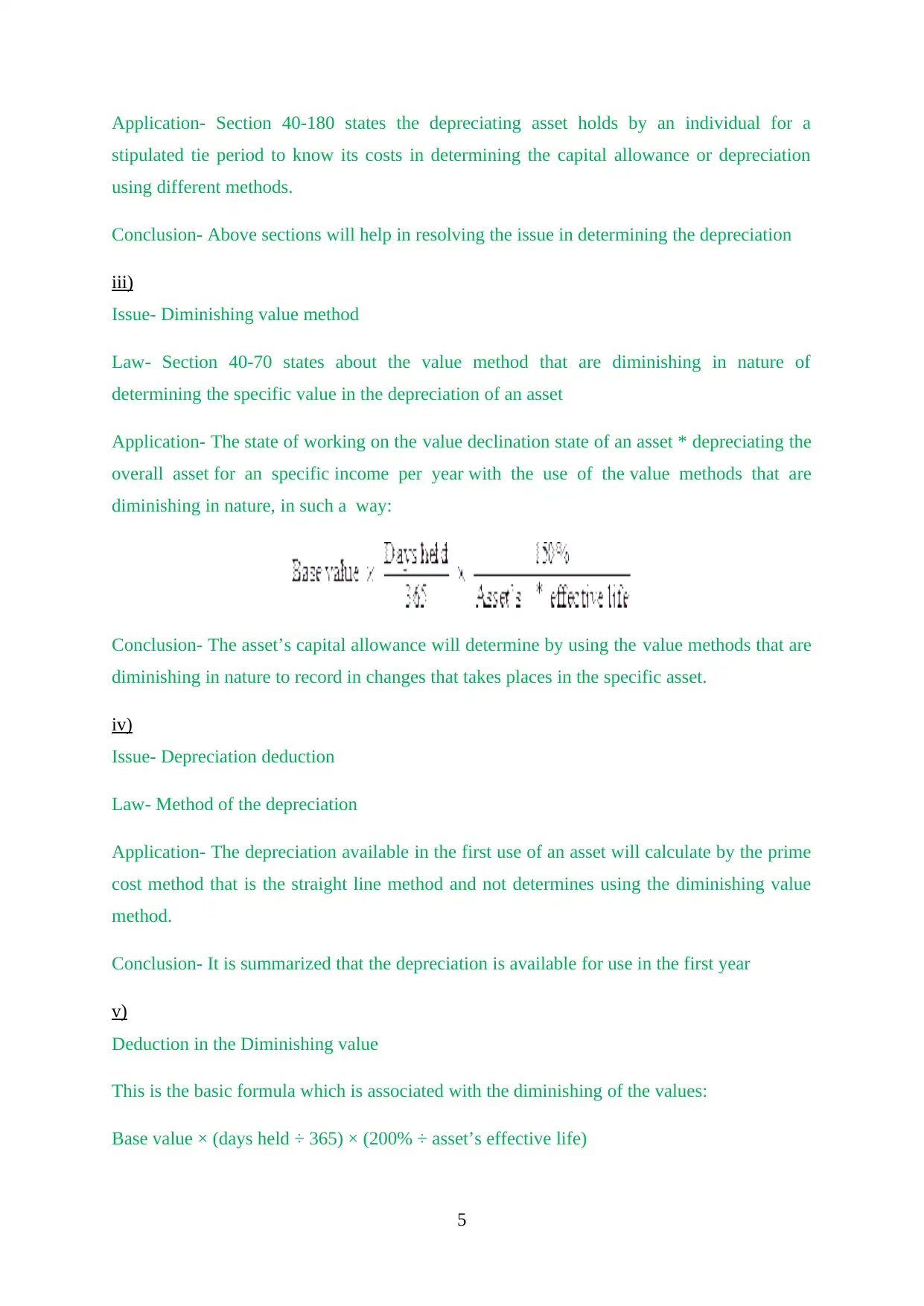
stipulated tie period to know its costs in determining the capital allowance or depreciation
using different methods.
Conclusion- Above sections will help in resolving the issue in determining the depreciation
iii)
Issue- Diminishing value method
Law- Section 40-70 states about the value method that are diminishing in nature of
determining the specific value in the depreciation of an asset
Application- The state of working on the value declination state of an asset * depreciating the
overall asset for an specific income per year with the use of the value methods that are
diminishing in nature, in such a way:
Conclusion- The asset’s capital allowance will determine by using the value methods that are
diminishing in nature to record in changes that takes places in the specific asset.
iv)
Issue- Depreciation deduction
Law- Method of the depreciation
Application- The depreciation available in the first use of an asset will calculate by the prime
cost method that is the straight line method and not determines using the diminishing value
method.
Conclusion- It is summarized that the depreciation is available for use in the first year
v)
Deduction in the Diminishing value
This is the basic formula which is associated with the diminishing of the values:
Base value × (days held ÷ 365) × (200% ÷ asset’s effective life)
5
⊘ This is a preview!⊘
Do you want full access?
Subscribe today to unlock all pages.

Trusted by 1+ million students worldwide
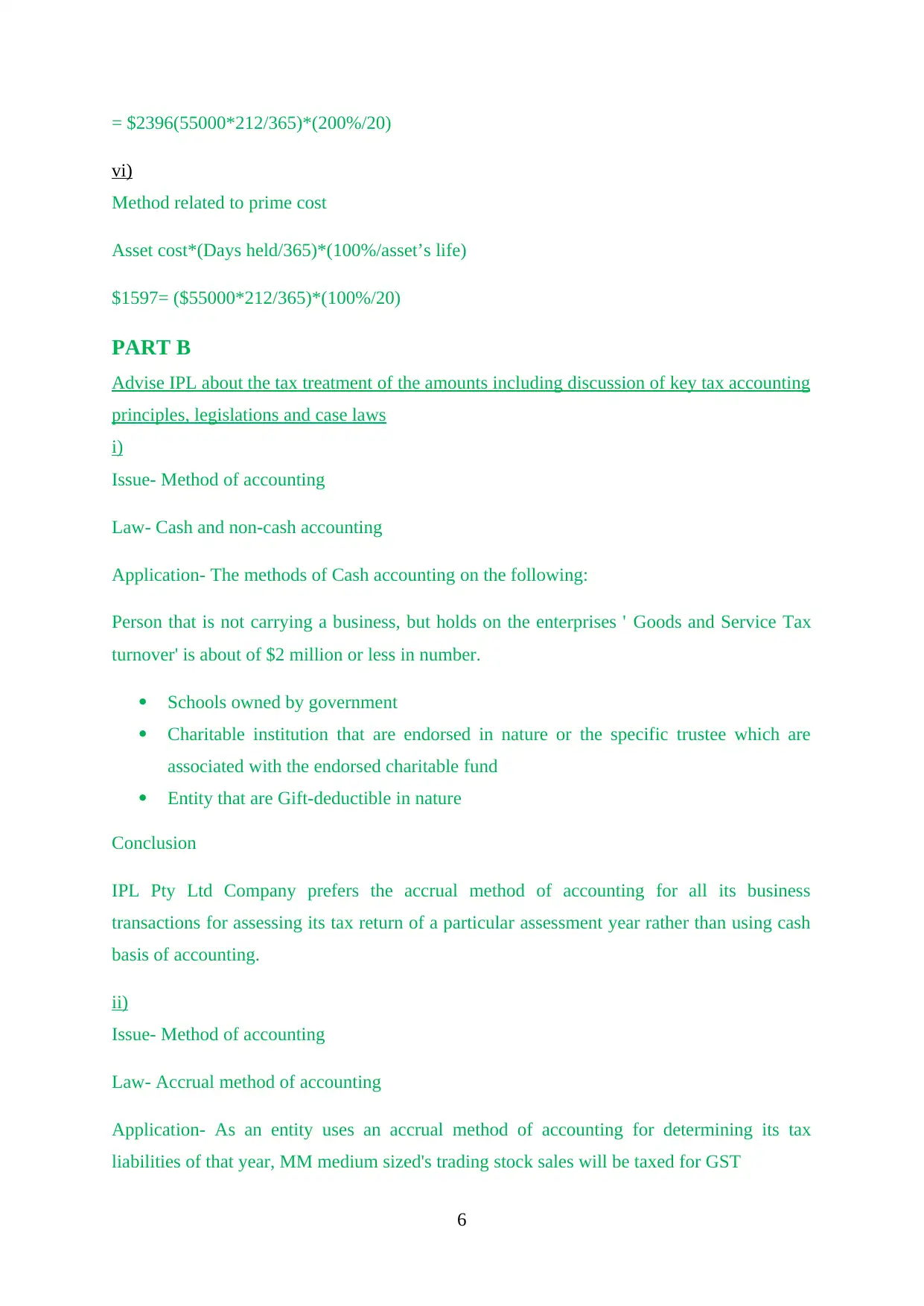
vi)
Method related to prime cost
Asset cost*(Days held/365)*(100%/asset’s life)
$1597= ($55000*212/365)*(100%/20)
PART B
Advise IPL about the tax treatment of the amounts including discussion of key tax accounting
principles, legislations and case laws
i)
Issue- Method of accounting
Law- Cash and non-cash accounting
Application- The methods of Cash accounting on the following:
Person that is not carrying a business, but holds on the enterprises ' Goods and Service Tax
turnover' is about of $2 million or less in number.
Schools owned by government
Charitable institution that are endorsed in nature or the specific trustee which are
associated with the endorsed charitable fund
Entity that are Gift-deductible in nature
Conclusion
IPL Pty Ltd Company prefers the accrual method of accounting for all its business
transactions for assessing its tax return of a particular assessment year rather than using cash
basis of accounting.
ii)
Issue- Method of accounting
Law- Accrual method of accounting
Application- As an entity uses an accrual method of accounting for determining its tax
liabilities of that year, MM medium sized's trading stock sales will be taxed for GST
6
Paraphrase This Document
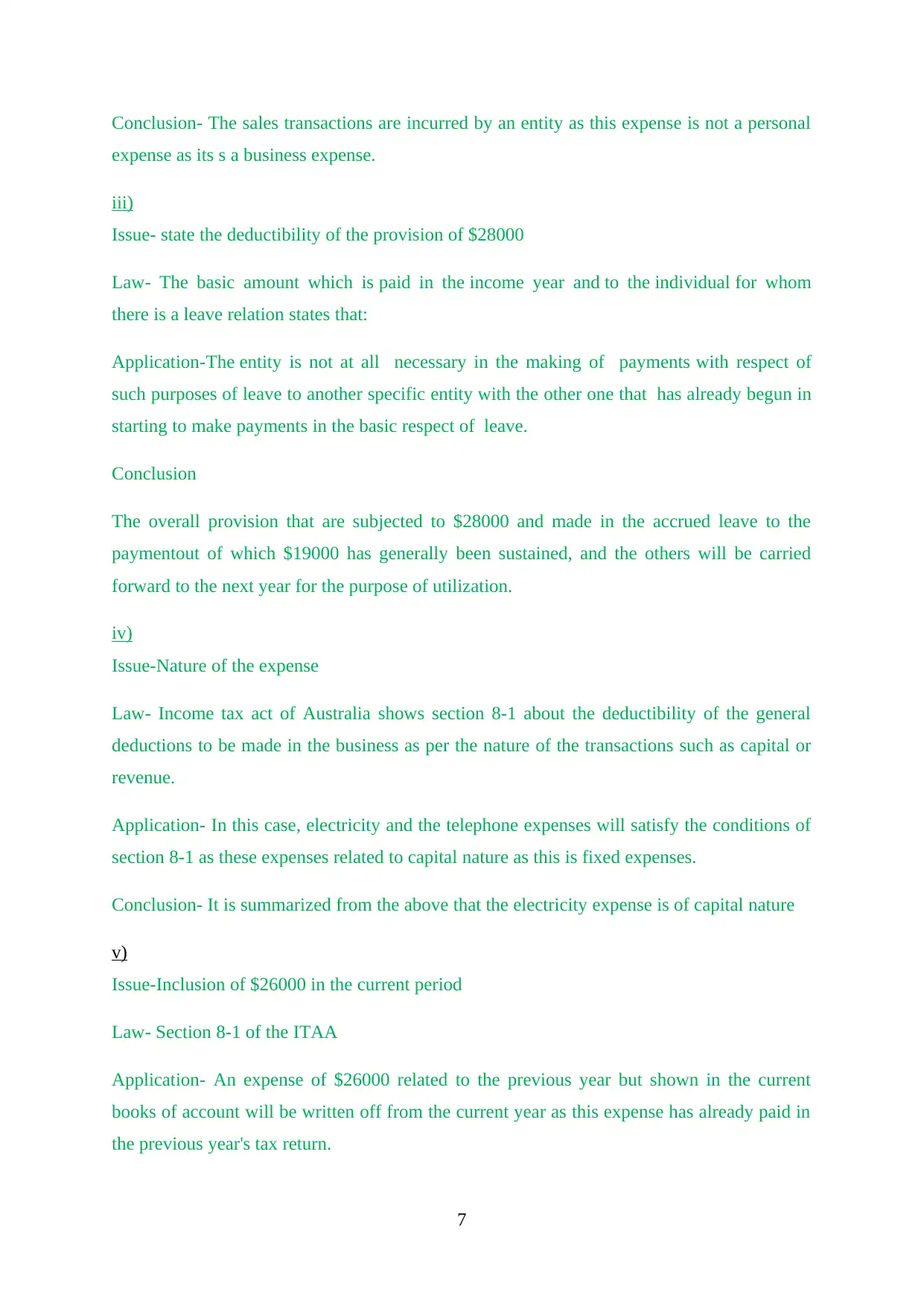
expense as its s a business expense.
iii)
Issue- state the deductibility of the provision of $28000
Law- The basic amount which is paid in the income year and to the individual for whom
there is a leave relation states that:
Application-The entity is not at all necessary in the making of payments with respect of
such purposes of leave to another specific entity with the other one that has already begun in
starting to make payments in the basic respect of leave.
Conclusion
The overall provision that are subjected to $28000 and made in the accrued leave to the
paymentout of which $19000 has generally been sustained, and the others will be carried
forward to the next year for the purpose of utilization.
iv)
Issue-Nature of the expense
Law- Income tax act of Australia shows section 8-1 about the deductibility of the general
deductions to be made in the business as per the nature of the transactions such as capital or
revenue.
Application- In this case, electricity and the telephone expenses will satisfy the conditions of
section 8-1 as these expenses related to capital nature as this is fixed expenses.
Conclusion- It is summarized from the above that the electricity expense is of capital nature
v)
Issue-Inclusion of $26000 in the current period
Law- Section 8-1 of the ITAA
Application- An expense of $26000 related to the previous year but shown in the current
books of account will be written off from the current year as this expense has already paid in
the previous year's tax return.
7
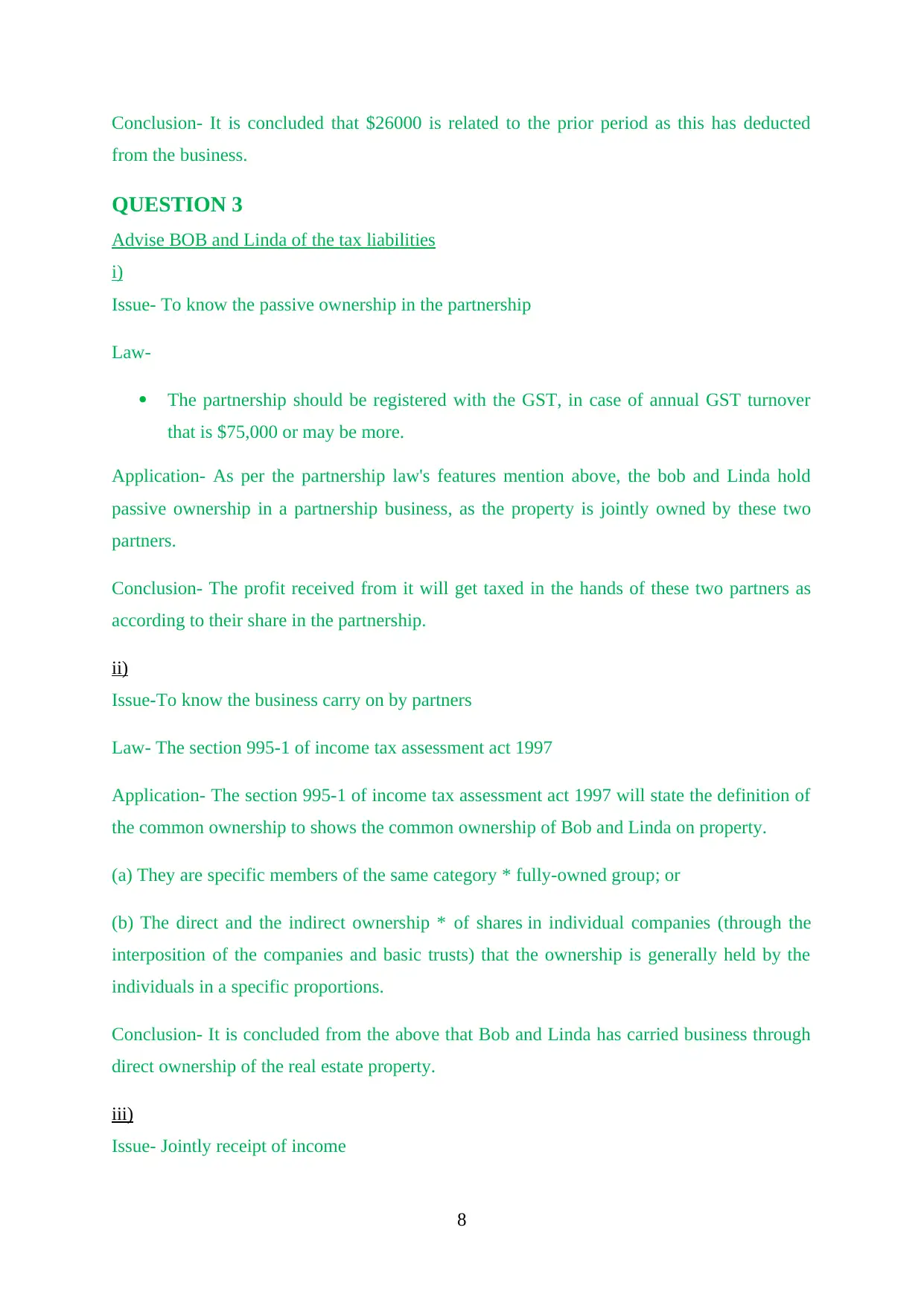
from the business.
QUESTION 3
Advise BOB and Linda of the tax liabilities
i)
Issue- To know the passive ownership in the partnership
Law-
The partnership should be registered with the GST, in case of annual GST turnover
that is $75,000 or may be more.
Application- As per the partnership law's features mention above, the bob and Linda hold
passive ownership in a partnership business, as the property is jointly owned by these two
partners.
Conclusion- The profit received from it will get taxed in the hands of these two partners as
according to their share in the partnership.
ii)
Issue-To know the business carry on by partners
Law- The section 995-1 of income tax assessment act 1997
Application- The section 995-1 of income tax assessment act 1997 will state the definition of
the common ownership to shows the common ownership of Bob and Linda on property.
(a) They are specific members of the same category * fully-owned group; or
(b) The direct and the indirect ownership * of shares in individual companies (through the
interposition of the companies and basic trusts) that the ownership is generally held by the
individuals in a specific proportions.
Conclusion- It is concluded from the above that Bob and Linda has carried business through
direct ownership of the real estate property.
iii)
Issue- Jointly receipt of income
8
⊘ This is a preview!⊘
Do you want full access?
Subscribe today to unlock all pages.

Trusted by 1+ million students worldwide
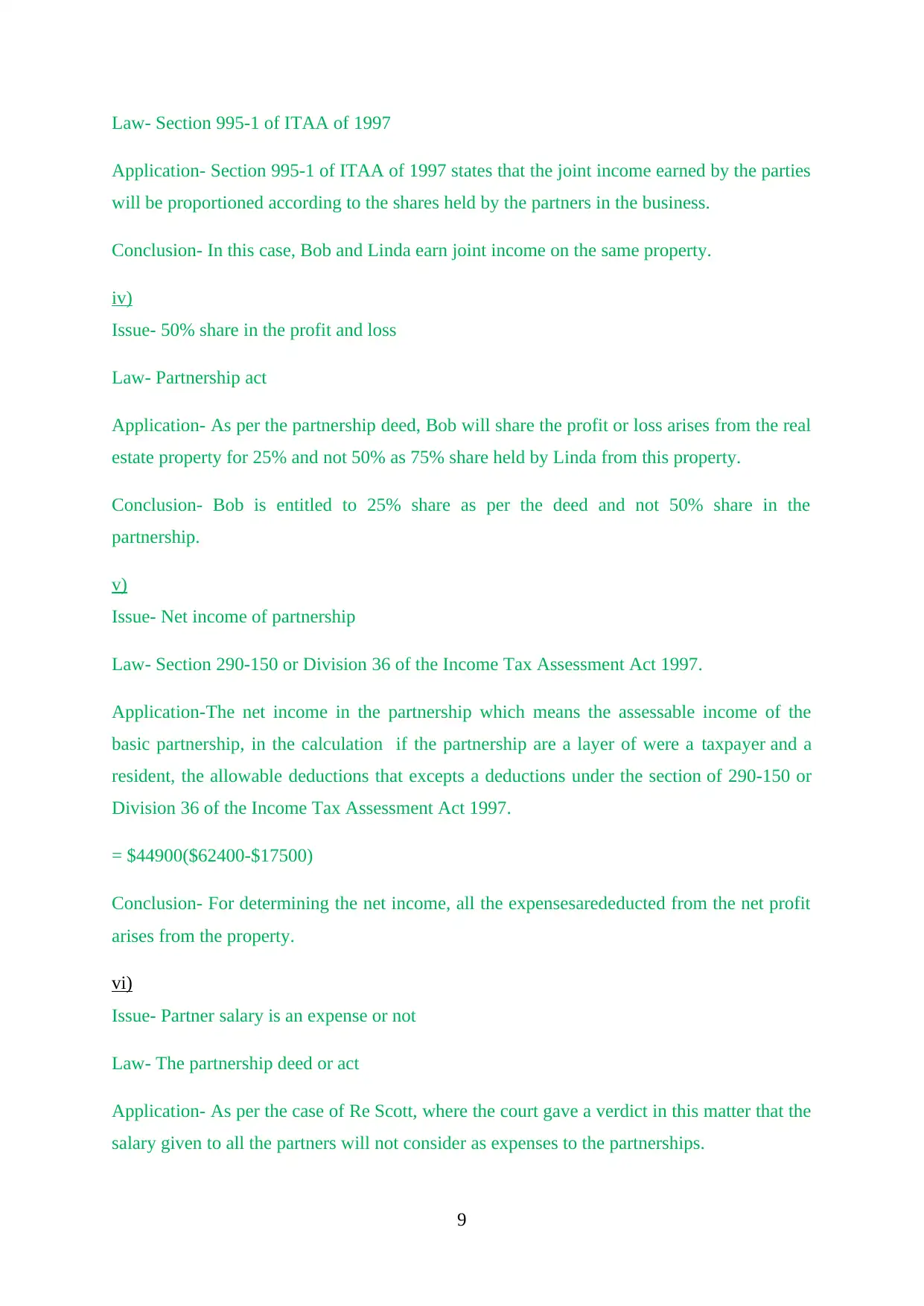
Application- Section 995-1 of ITAA of 1997 states that the joint income earned by the parties
will be proportioned according to the shares held by the partners in the business.
Conclusion- In this case, Bob and Linda earn joint income on the same property.
iv)
Issue- 50% share in the profit and loss
Law- Partnership act
Application- As per the partnership deed, Bob will share the profit or loss arises from the real
estate property for 25% and not 50% as 75% share held by Linda from this property.
Conclusion- Bob is entitled to 25% share as per the deed and not 50% share in the
partnership.
v)
Issue- Net income of partnership
Law- Section 290-150 or Division 36 of the Income Tax Assessment Act 1997.
Application-The net income in the partnership which means the assessable income of the
basic partnership, in the calculation if the partnership are a layer of were a taxpayer and a
resident, the allowable deductions that excepts a deductions under the section of 290-150 or
Division 36 of the Income Tax Assessment Act 1997.
= $44900($62400-$17500)
Conclusion- For determining the net income, all the expensesarededucted from the net profit
arises from the property.
vi)
Issue- Partner salary is an expense or not
Law- The partnership deed or act
Application- As per the case of Re Scott, where the court gave a verdict in this matter that the
salary given to all the partners will not consider as expenses to the partnerships.
9
Paraphrase This Document
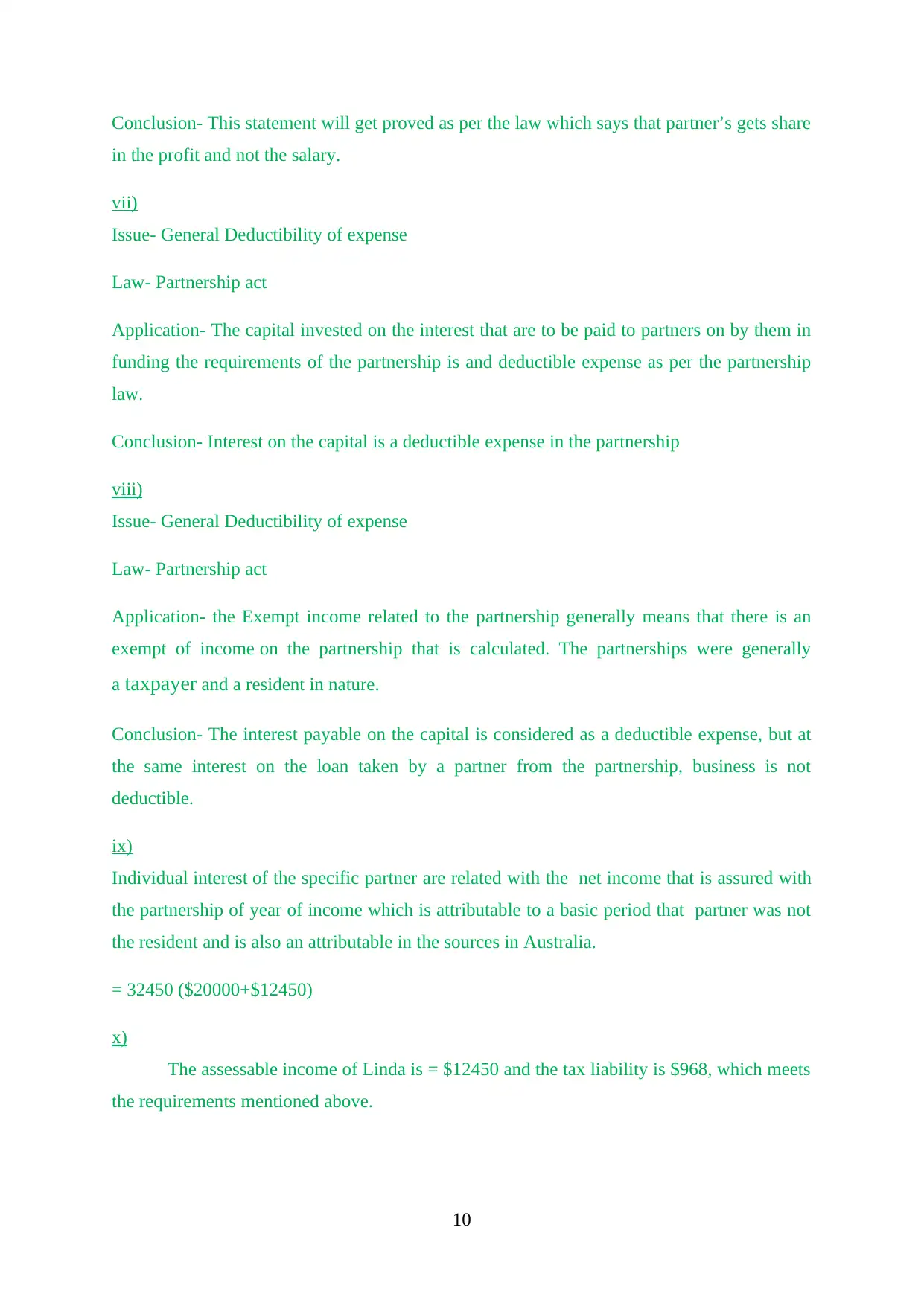
in the profit and not the salary.
vii)
Issue- General Deductibility of expense
Law- Partnership act
Application- The capital invested on the interest that are to be paid to partners on by them in
funding the requirements of the partnership is and deductible expense as per the partnership
law.
Conclusion- Interest on the capital is a deductible expense in the partnership
viii)
Issue- General Deductibility of expense
Law- Partnership act
Application- the Exempt income related to the partnership generally means that there is an
exempt of income on the partnership that is calculated. The partnerships were generally
a taxpayer and a resident in nature.
Conclusion- The interest payable on the capital is considered as a deductible expense, but at
the same interest on the loan taken by a partner from the partnership, business is not
deductible.
ix)
Individual interest of the specific partner are related with the net income that is assured with
the partnership of year of income which is attributable to a basic period that partner was not
the resident and is also an attributable in the sources in Australia.
= 32450 ($20000+$12450)
x)
The assessable income of Linda is = $12450 and the tax liability is $968, which meets
the requirements mentioned above.
10

PART A
Explain relevant parties using tax legislations and cases the tax payable under this trust
arrangement
i)
Issue- net income of trust
Law-Division 393 of the Income Tax Assessment Act 199
Application- The net income with relation to the Division 393 of the Income Tax Assessment
Act 1997 and except also, in this respect of the beneficiary it has an interest in the overall
corpus that are related with trust estate, or in respect with the life tenant, the allowable
deductions that are synchronised under Division 36 of the Income Tax Assessment Act
1997 in respect of such of the tax and the losses to be met out of corpus.
Conclusion-As per the regulations are given above the net income of the trust is $27000 after
deducting all the expenses.
ii)
Issue- Personal excretion
Law- Section 101
Application- Section 101 shows the discretionary income received by Bob from the trust as a
felicitation will tax in the hands of the receiver.
Conclusion- The benefit of beneficiaries, in whose favour the overall trustee exercises shall
be deemed with respect to the entitled amount paid for the benefit of the beneficiary's.
iii)
Issue- Normal rates of tax liability
Law- Section 97
Application- A beneficiary is required to meet certain conditions to get the share of the net
income of the trust is:
Person that are natural
Resident of the income year at the end
11
⊘ This is a preview!⊘
Do you want full access?
Subscribe today to unlock all pages.

Trusted by 1+ million students worldwide
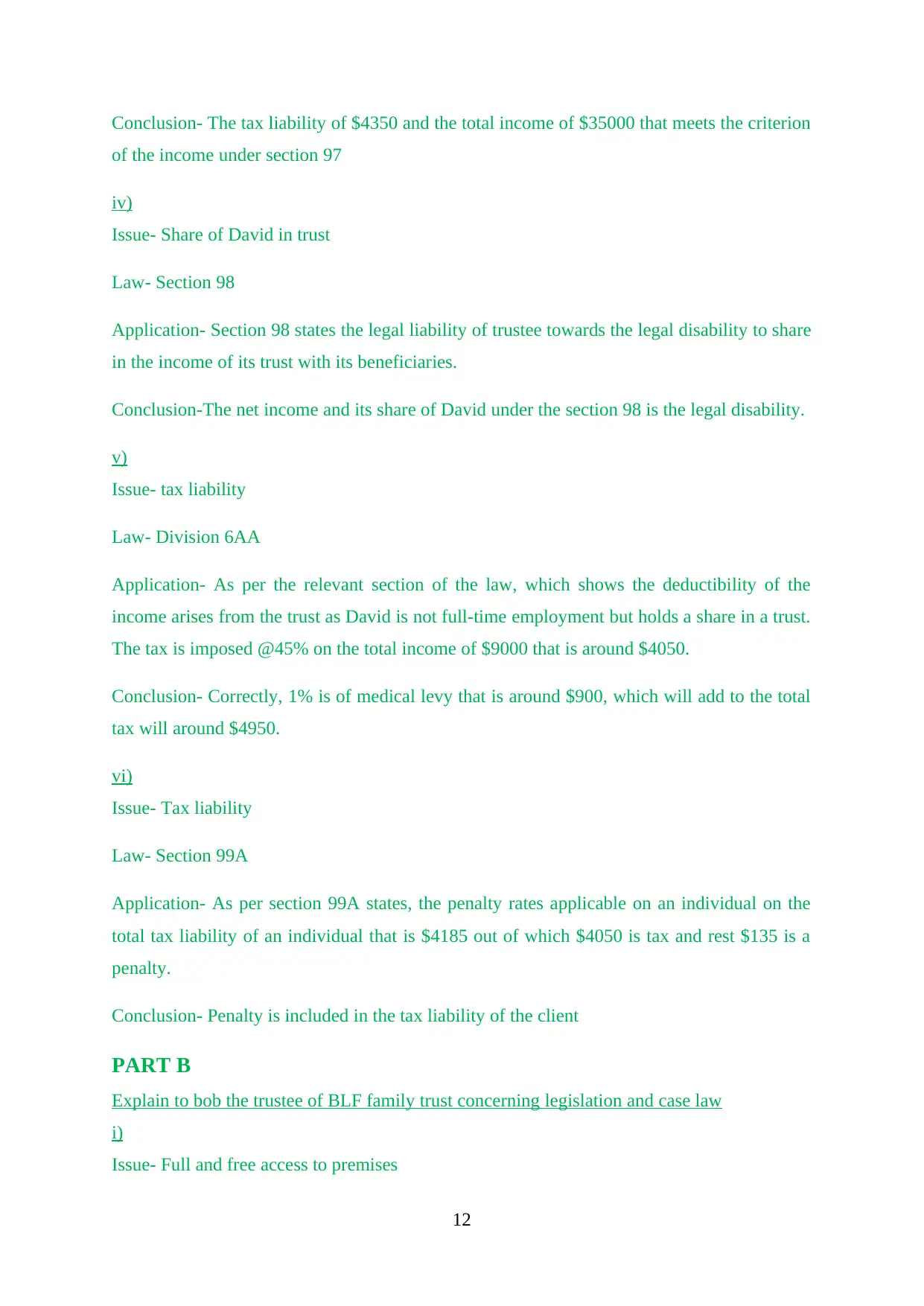
of the income under section 97
iv)
Issue- Share of David in trust
Law- Section 98
Application- Section 98 states the legal liability of trustee towards the legal disability to share
in the income of its trust with its beneficiaries.
Conclusion-The net income and its share of David under the section 98 is the legal disability.
v)
Issue- tax liability
Law- Division 6AA
Application- As per the relevant section of the law, which shows the deductibility of the
income arises from the trust as David is not full-time employment but holds a share in a trust.
The tax is imposed @45% on the total income of $9000 that is around $4050.
Conclusion- Correctly, 1% is of medical levy that is around $900, which will add to the total
tax will around $4950.
vi)
Issue- Tax liability
Law- Section 99A
Application- As per section 99A states, the penalty rates applicable on an individual on the
total tax liability of an individual that is $4185 out of which $4050 is tax and rest $135 is a
penalty.
Conclusion- Penalty is included in the tax liability of the client
PART B
Explain to bob the trustee of BLF family trust concerning legislation and case law
i)
Issue- Full and free access to premises
12
Paraphrase This Document
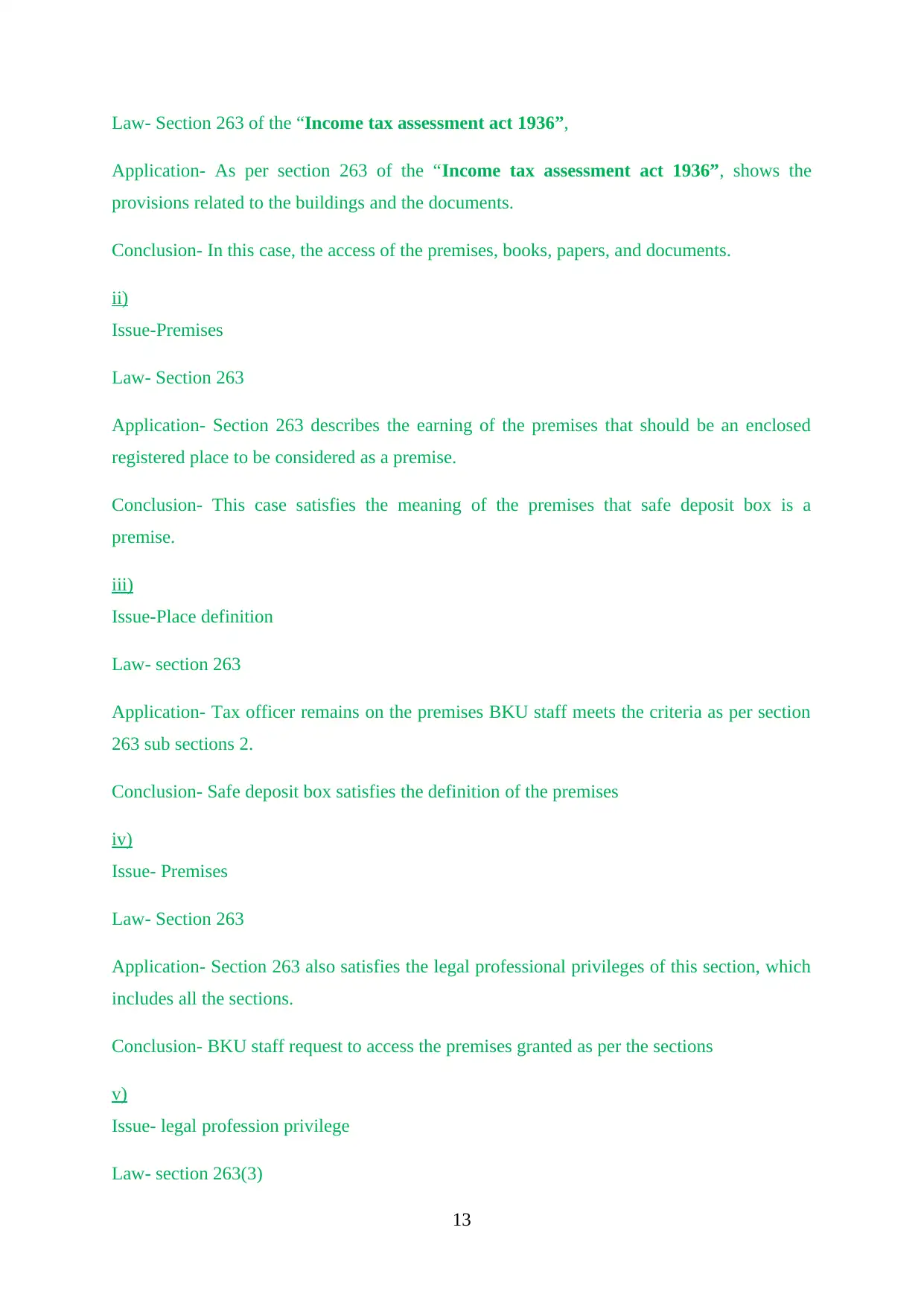
Application- As per section 263 of the “Income tax assessment act 1936”, shows the
provisions related to the buildings and the documents.
Conclusion- In this case, the access of the premises, books, papers, and documents.
ii)
Issue-Premises
Law- Section 263
Application- Section 263 describes the earning of the premises that should be an enclosed
registered place to be considered as a premise.
Conclusion- This case satisfies the meaning of the premises that safe deposit box is a
premise.
iii)
Issue-Place definition
Law- section 263
Application- Tax officer remains on the premises BKU staff meets the criteria as per section
263 sub sections 2.
Conclusion- Safe deposit box satisfies the definition of the premises
iv)
Issue- Premises
Law- Section 263
Application- Section 263 also satisfies the legal professional privileges of this section, which
includes all the sections.
Conclusion- BKU staff request to access the premises granted as per the sections
v)
Issue- legal profession privilege
Law- section 263(3)
13

conditions appropriately.
Conclusion- Not granted as against the sections
vi)
Issue-Smashing safety deposit box
Law- Sections of ITAA
Application- The definition of the premises states the safety deposit falls under the definition
of the premises, so the statement is not correct.
Conclusion- Did not meets the requirements
QUESTION 5
PART A
Advise Maddox meats pty ltd about the GST implications showing calculations and
legislations
i)
Issue- Feasibility of Maddox’s business under GST
Law- Section 23-10
Application- Section 23-10 States that the person is not required registering itself with the
goods and servicing tax are mention as below:
a) Persons engaged exclusively in supplying products/services/both not liable to tax.
Conclusion-GST threshold is 2 lakh, and the client's turnover is $75000, so they did not cover
under GST
ii)
Issue- Taxable supply or not
Law- Section 9-5 of GST act
Application- Section 9-5 shows the taxable supplies when following conditions satisfies
mention as below:
14
⊘ This is a preview!⊘
Do you want full access?
Subscribe today to unlock all pages.

Trusted by 1+ million students worldwide

(b) The supply which is done in overall course *enterprises which is you *carrying on; and
Conclusion-Supply MMPL is a taxable supply
iii)
Issue- Supply is GST free or not
Law- Section 38 sub section 2
Application- Section 38 sub section 2 states all the supplies which are outside the
purview from the goods and service tax are mention as below:
Free supply of food
Supply of inter state
Conclusion- Goods for consideration in course of business are not GST free supply
iv)
Issue- Creditable acquisition
Law- Section 11-5 of GST act
Application-“Section 11-5” shows the overall acquisition that is creditable in the respective
cases mentions below:
The acquiring can be anything solely or partly depending on the purpose of
creditability; and
The basic supply which is a taxable in supply; and
You can provide or in the state of liability in providing, with consideration for supply
Conclusion- Purchase of new fridge for the business is creditable acquisition as this supply is
taxable supply.
v)
Issue- Input tax credit
Law- Section 9-75 of the goods and service tax
Application- Section 9-75 of the goods and service tax shows the input tax credit in which tax
is payable when a client purchase anything from a registered seller.
15
Paraphrase This Document
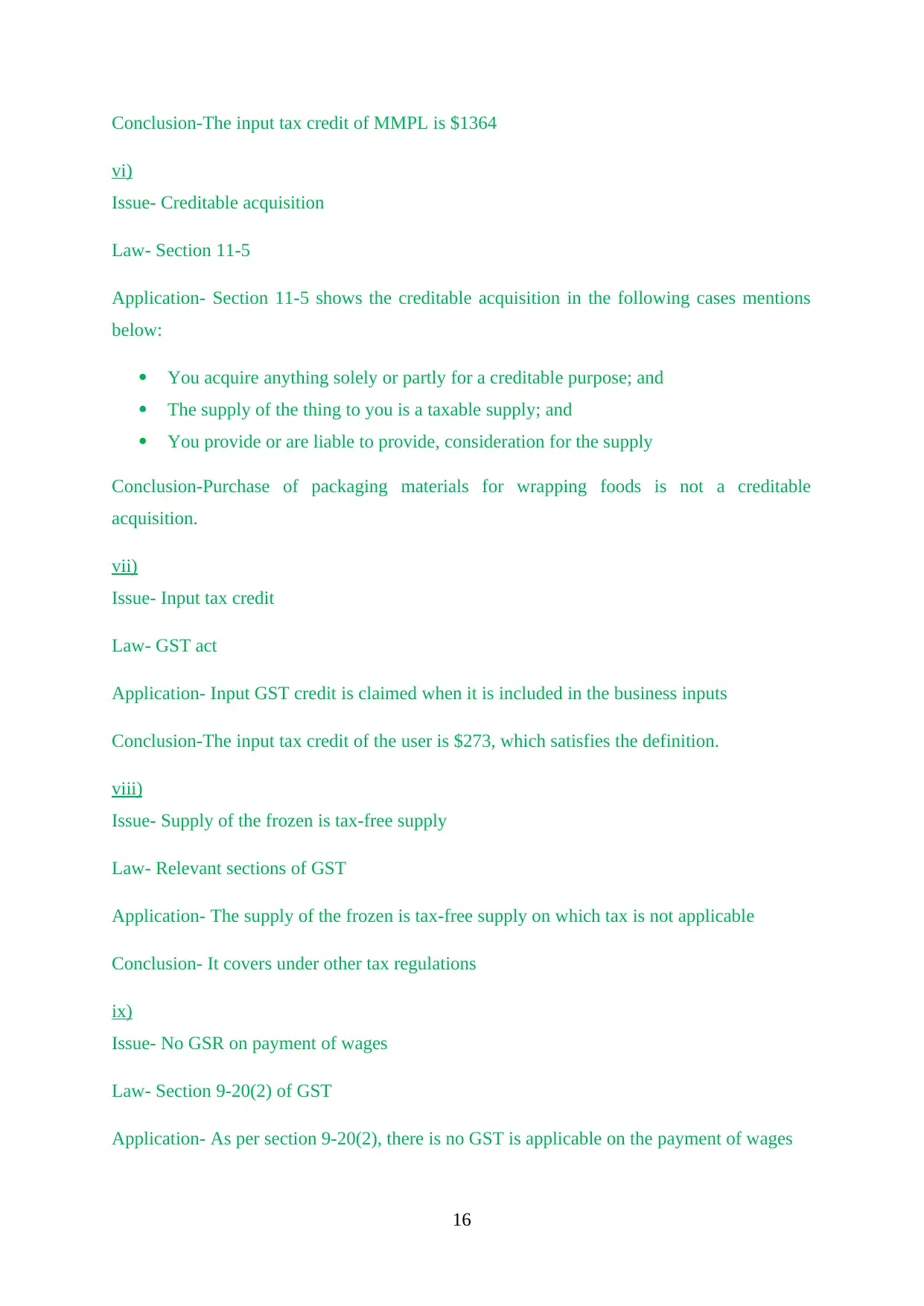
vi)
Issue- Creditable acquisition
Law- Section 11-5
Application- Section 11-5 shows the creditable acquisition in the following cases mentions
below:
You acquire anything solely or partly for a creditable purpose; and
The supply of the thing to you is a taxable supply; and
You provide or are liable to provide, consideration for the supply
Conclusion-Purchase of packaging materials for wrapping foods is not a creditable
acquisition.
vii)
Issue- Input tax credit
Law- GST act
Application- Input GST credit is claimed when it is included in the business inputs
Conclusion-The input tax credit of the user is $273, which satisfies the definition.
viii)
Issue- Supply of the frozen is tax-free supply
Law- Relevant sections of GST
Application- The supply of the frozen is tax-free supply on which tax is not applicable
Conclusion- It covers under other tax regulations
ix)
Issue- No GSR on payment of wages
Law- Section 9-20(2) of GST
Application- As per section 9-20(2), there is no GST is applicable on the payment of wages
16
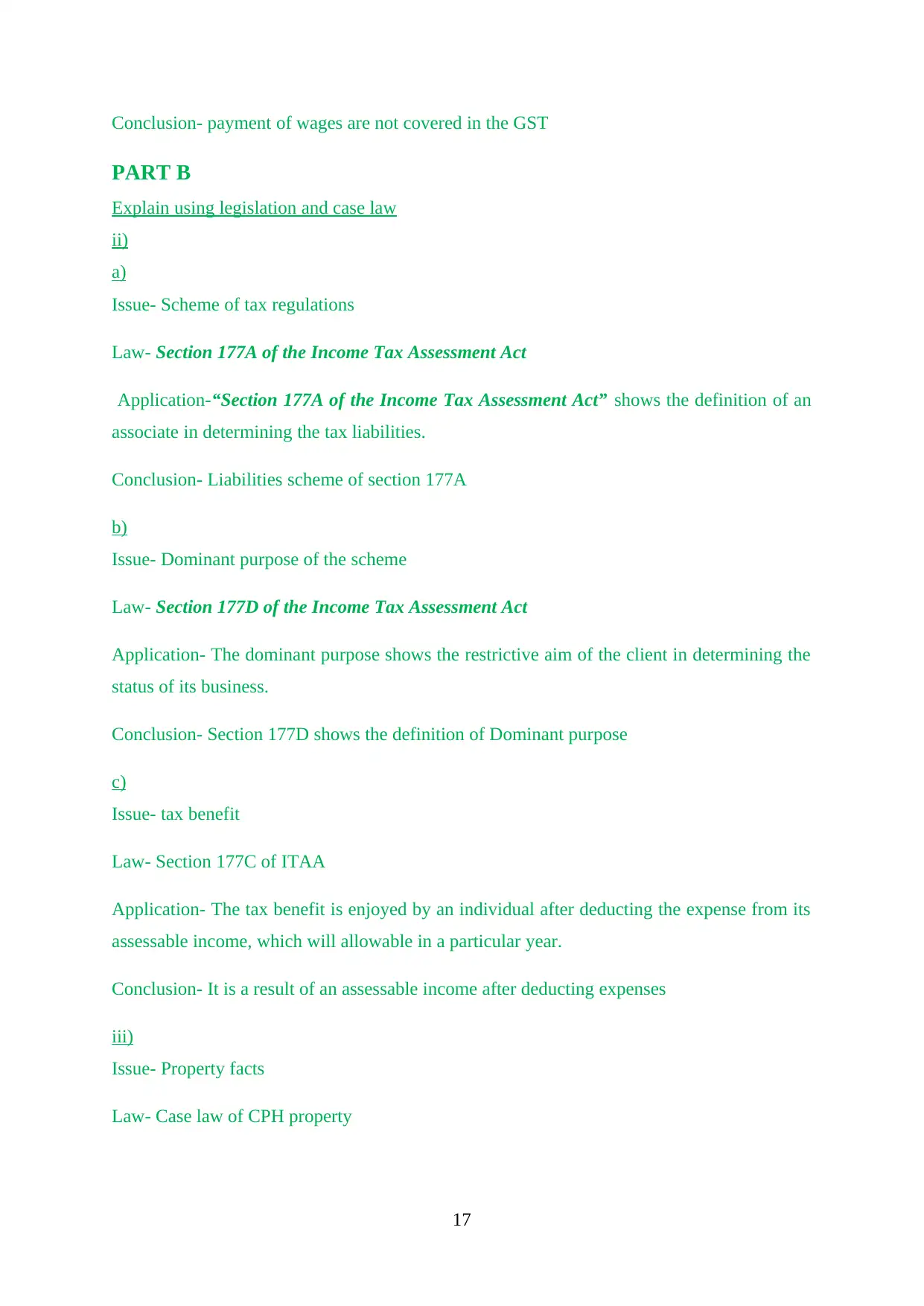
PART B
Explain using legislation and case law
ii)
a)
Issue- Scheme of tax regulations
Law- Section 177A of the Income Tax Assessment Act
Application-“Section 177A of the Income Tax Assessment Act” shows the definition of an
associate in determining the tax liabilities.
Conclusion- Liabilities scheme of section 177A
b)
Issue- Dominant purpose of the scheme
Law- Section 177D of the Income Tax Assessment Act
Application- The dominant purpose shows the restrictive aim of the client in determining the
status of its business.
Conclusion- Section 177D shows the definition of Dominant purpose
c)
Issue- tax benefit
Law- Section 177C of ITAA
Application- The tax benefit is enjoyed by an individual after deducting the expense from its
assessable income, which will allowable in a particular year.
Conclusion- It is a result of an assessable income after deducting expenses
iii)
Issue- Property facts
Law- Case law of CPH property
17
⊘ This is a preview!⊘
Do you want full access?
Subscribe today to unlock all pages.

Trusted by 1+ million students worldwide
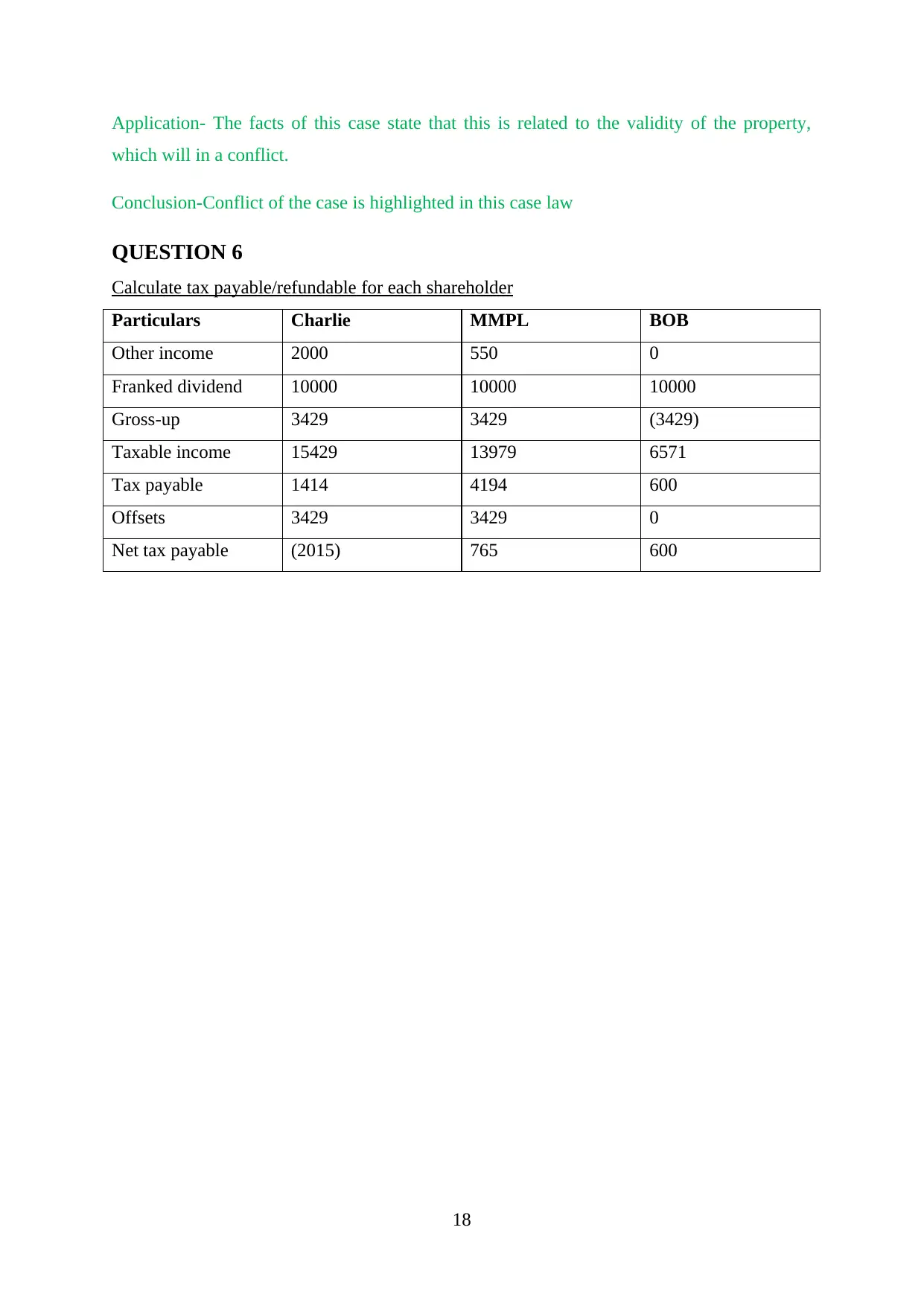
which will in a conflict.
Conclusion-Conflict of the case is highlighted in this case law
QUESTION 6
Calculate tax payable/refundable for each shareholder
Particulars Charlie MMPL BOB
Other income 2000 550 0
Franked dividend 10000 10000 10000
Gross-up 3429 3429 (3429)
Taxable income 15429 13979 6571
Tax payable 1414 4194 600
Offsets 3429 3429 0
Net tax payable (2015) 765 600
18
Paraphrase This Document
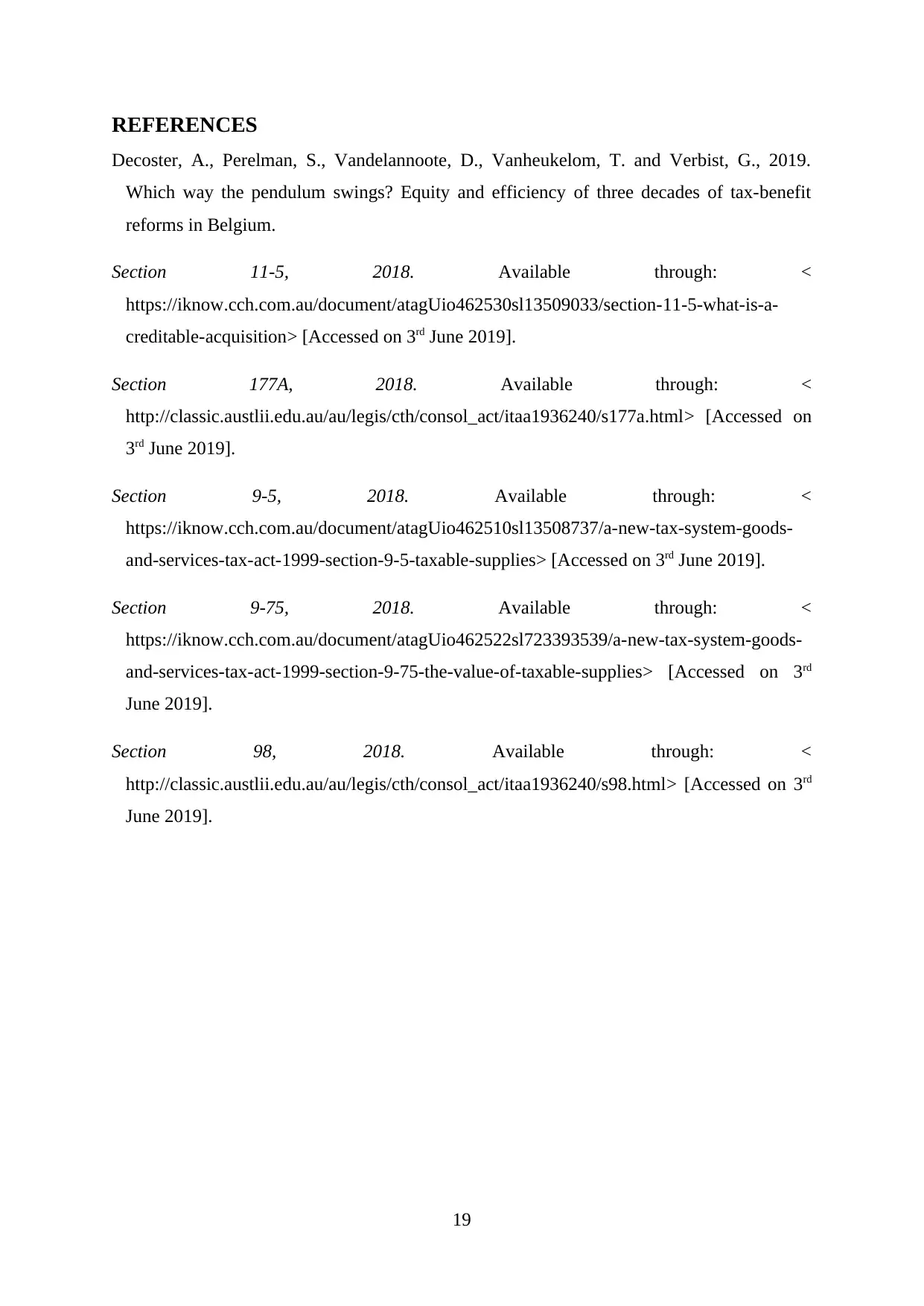
Decoster, A., Perelman, S., Vandelannoote, D., Vanheukelom, T. and Verbist, G., 2019.
Which way the pendulum swings? Equity and efficiency of three decades of tax-benefit
reforms in Belgium.
Section 11-5, 2018. Available through: <
https://iknow.cch.com.au/document/atagUio462530sl13509033/section-11-5-what-is-a-
creditable-acquisition> [Accessed on 3rd June 2019].
Section 177A, 2018. Available through: <
http://classic.austlii.edu.au/au/legis/cth/consol_act/itaa1936240/s177a.html> [Accessed on
3rd June 2019].
Section 9-5, 2018. Available through: <
https://iknow.cch.com.au/document/atagUio462510sl13508737/a-new-tax-system-goods-
and-services-tax-act-1999-section-9-5-taxable-supplies> [Accessed on 3rd June 2019].
Section 9-75, 2018. Available through: <
https://iknow.cch.com.au/document/atagUio462522sl723393539/a-new-tax-system-goods-
and-services-tax-act-1999-section-9-75-the-value-of-taxable-supplies> [Accessed on 3rd
June 2019].
Section 98, 2018. Available through: <
http://classic.austlii.edu.au/au/legis/cth/consol_act/itaa1936240/s98.html> [Accessed on 3rd
June 2019].
19
Related Documents
Your All-in-One AI-Powered Toolkit for Academic Success.
+13062052269
info@desklib.com
Available 24*7 on WhatsApp / Email
![[object Object]](/_next/static/media/star-bottom.7253800d.svg)
© 2024 | Zucol Services PVT LTD | All rights reserved.





